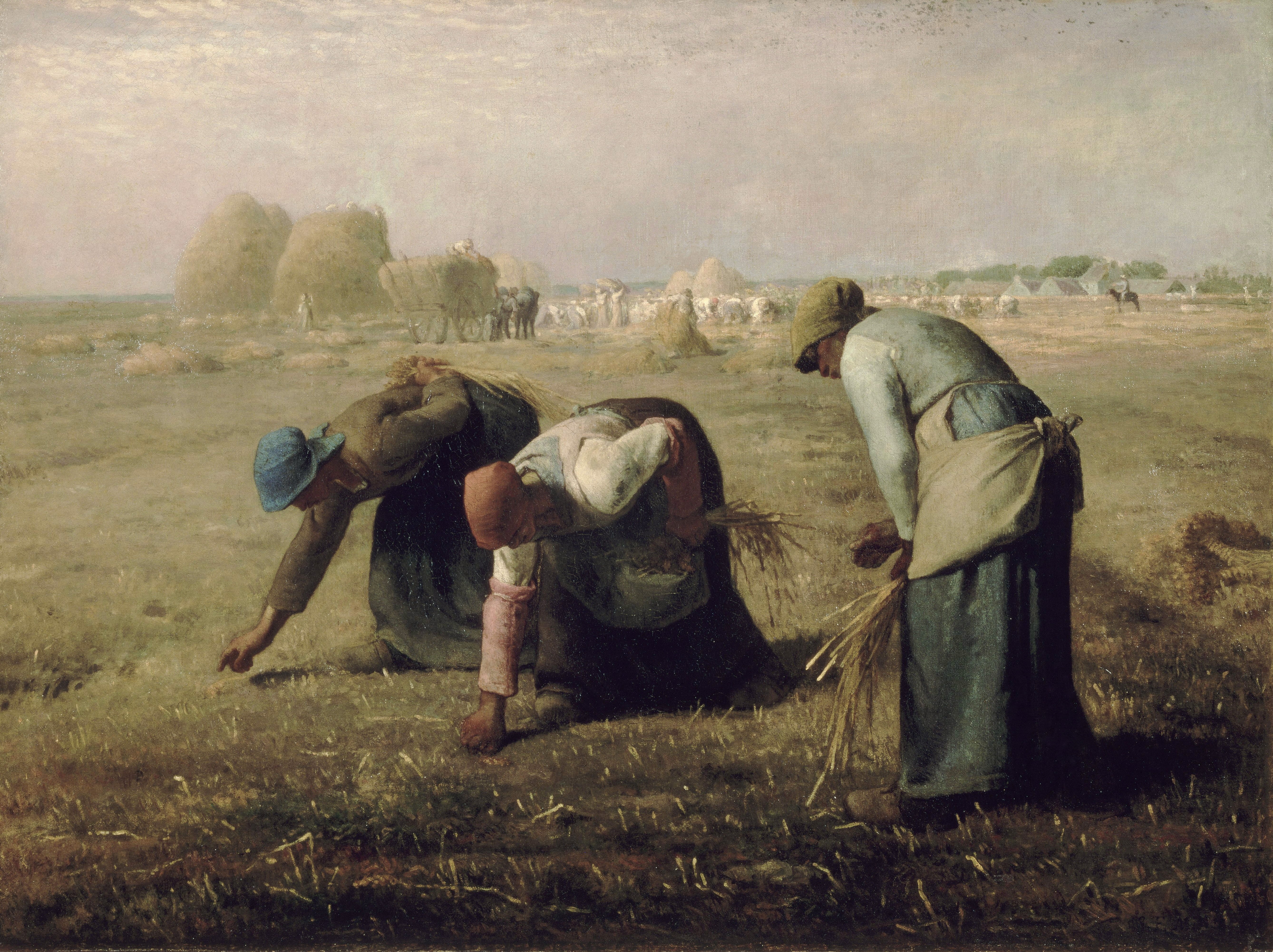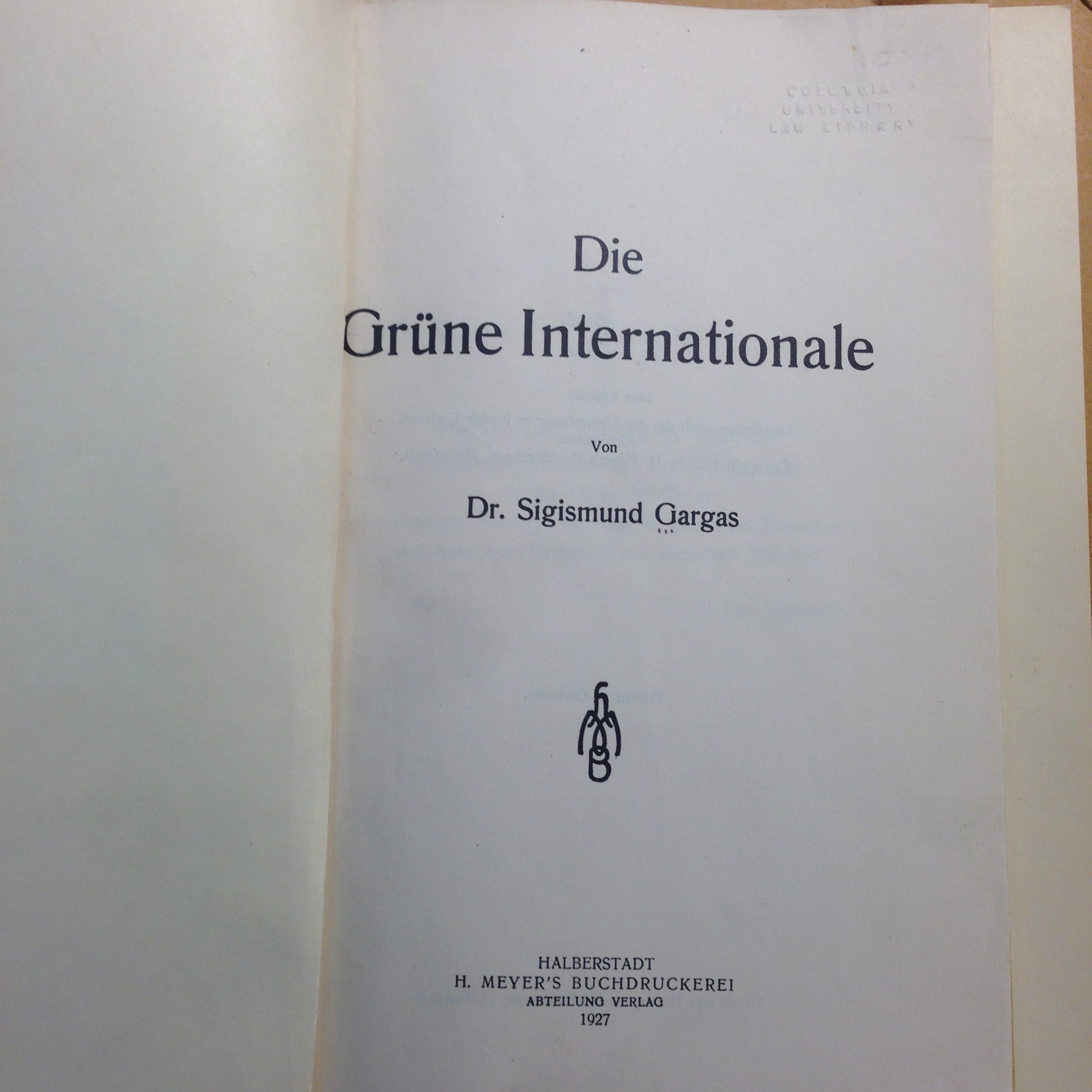by contributing editor Carolyn Taratko
The image of the farmer tilling his field is an enduring one; it evokes meaningful labor, ties to the natural world, and self-sufficiency. However, such images were not always interpreted this way. When Jean-François Millet’s The Gleaners debuted at the Paris salon of 1857, its unflinching depiction of social inequality and coarse rural life appalled visitors; for some, like the art critic of Le Figaro, it constituted nothing less than a call for revolution and conjured up the “pikes of ‘93”. By the end of the century the painting had become an iconic, perhaps even the iconic image of the French nation. It no longer threatened with revolution–quite the opposite. During World War I Millet’s work was employed as propaganda in the service of the French nation. The peasant became the standard-bearer for nationalist and conservative values across Europe.

Jean-François Millet’s The Gleaners (Musée d’Orsay)
The story of Millet’s Gleaners and its peregrination from fringe threat to fixture of the establishment reminds us that there is more to agrarian life than meets the eye. In Western Europe, it is a challenge for the modern imagination to conceive of cultivating one’s own plot of land as anything other than the most parochial activity. Those who tilled the fields tended to be miles away from modern cities and centers of power. Within the historical profession, swelling interest in global history–time zones, telegraphs, railroads– has all but pushed the agrarian world from view. To put it with Raymond Williams, the countryside is commonly regarded as “weather or a place for walk”, but not generally for revolution , internationalism or self-mobilization (166).
Upon closer consideration, it becomes clear that the European countryside was also enmeshed in the logic of these globalizing tendencies and not merely as a pawn of ruling interests. Across Europe, cooperatives sprung up to facilitate the purchase machinery and access to credit and agricultural schools multiplied. To cite the German case, in the years following unification, agricultural institutes were founded in 1871 at Gießen, 1874 in Munich, 1876 in Königsberg, 1879 in Bonn, 1880 in Breslau. In Berlin, an independent agricultural university was founded in 1889 (Bd. 3, 696). Teachers and practitioners congregated at regional fairs and international agricultural conferences to exchange knowledge about cultivation practices and technology. These networks extended across the Atlantic, to the United States and Canada as well. To cite just one example, reports compiled by the International Institute for Agriculture in Rome influenced policy makers in the United States, ushering in a system of credit for agriculture in the form of the Federal Farm Loan Act of 1910 that was based on the German model.
The cataclysm of the First World War also served as a reminder of the importance of Europe’s agrarian base. Faced with a British blockade, Germany and Austria-Hungary were forced to rely on their own peasantry for food production. Among the Central Powers, this contributed to strain between cities and the surrounding countryside. Prolonged shortages in foodstuffs nurtured a thriving black market and to the rise of so-called “hamstering” in Germany, a practice which had urban dwellers would head to the countryside to buy (but also steal and beg for) food from rural producers. Although they represented a diminishing share of the population, their work was as important as ever.
The end of the war and resultant peace gave rise to a vigorous spirit of internationalism. Having seen the destruction wrought by the rogue pursuit of national interests, international accords were hashed out to act as a brake on future conflict. While the League of Nations, founded in 1920 out of the Paris Peace Conference, worked through national representation, individuals were aligning themselves across national borders based on membership in other communities. Most notably this alignment took the form of the Comintern and renewed post-war appeals to the international working class, but it did not leave the agrarian countryside untouched.
 In 1927, Polish-born journalist Sigismund Gargas published a short exposition on the “Green International”, a coalition of forces that had existed for several decades and united the political and economic forces of agrarian interests. These “greens” had adopted the custom of flying colored banners for causes: red for international socialism and communism, black for the forces of conservative and aristocratic Catholicism, and a lesser-known white for international Christian interests “between the Red International and the Church”. In contrast to these ideologically committed forces, Gargas described the green counterpart as a more narrow group than the others, restricted to the occupational circle of landowners and laborers. As an interest group, members saw agriculture as the highest calling of human nature; beyond that the somewhat inchoate group did not subscribe to any single foundational idea. This, in itself, was no crime, wrote Gargas. In fact, when one scratched below the surface, he charged, a lack of agreement was a prevailing characteristic of all of these “internationals”.
In 1927, Polish-born journalist Sigismund Gargas published a short exposition on the “Green International”, a coalition of forces that had existed for several decades and united the political and economic forces of agrarian interests. These “greens” had adopted the custom of flying colored banners for causes: red for international socialism and communism, black for the forces of conservative and aristocratic Catholicism, and a lesser-known white for international Christian interests “between the Red International and the Church”. In contrast to these ideologically committed forces, Gargas described the green counterpart as a more narrow group than the others, restricted to the occupational circle of landowners and laborers. As an interest group, members saw agriculture as the highest calling of human nature; beyond that the somewhat inchoate group did not subscribe to any single foundational idea. This, in itself, was no crime, wrote Gargas. In fact, when one scratched below the surface, he charged, a lack of agreement was a prevailing characteristic of all of these “internationals”.Gargas, for his part, could not help himself from recommending “ideological content” for the Green International (5). He pled for a return to the physiocratic tradition which held that the soil was the ultimate source of all wealth. The originator of the idea, eighteenth-century French economist François Quesnay, held that only agriculture created surplus product, because only agriculture creates. Physiocrats advocated systems of land tenure that maximized this productivity. Like Quesnay and his circle, Gargas warned against government interference with the laws of nature. He directed his ire against protectionist tariffs in particular, at one point referring to them as “preconditions and origins of war… just as armaments and war are related, so too are protectionist tariffs” (17).
Another corollary of the original physiocratic program which appeared in the Green International was the importance placed upon private property. Gargas cites the vision of Dr. Ernst Laur, director of the Swiss Peasant’s Organization (Schweizerischer Bauernverband), then regarded as the leader of the Green International movement, who declared landholding to be a major international problem in the wake of the Bolshevik Revolution. The Green International, then, was to serve explicitly as a bulwark against the forces of expropriation and international communism. Nowhere was this more clear than at the Twelfth International Congress of Agriculture held in 1925 in Warsaw, where Laur, among others, congratulated attendees (joined by representatives from the former Central Powers for the first time since the war) on having forestalled revolution and improved yields.
Under the banner of the “Green International”, an array of interests came together to devise a way forward for the farmer tied to his land. Its activity in interwar Europe presented a sort of third way between revolutionary expropriation and the landed estates of the elite. The familiar (and facile) image of the staid life of the farmer belies both the turmoil and progress in the countryside. Even in areas where life remained agrarian, change was underway.



Leave a Reply